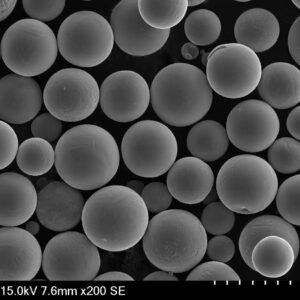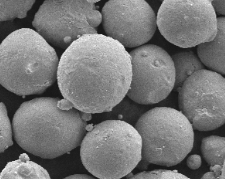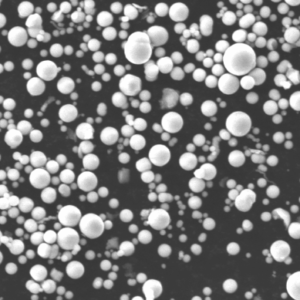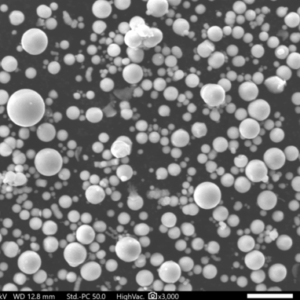Particle size distribution (PSD) is a fundamental concept in various fields, from pharmaceuticals to metallurgy, and is crucial for understanding material behavior, optimizing manufacturing processes, and ensuring product quality. Whether you’re dealing with metal powders, polymers, or pharmaceutical ingredients, grasping the intricacies of PSD can significantly impact your project’s success. This comprehensive guide delves into the key aspects of particle size distribution, focusing on its importance in metal powders, how it’s measured, and what it means for your applications.
Overview of Particle Size Distribution
Particle size distribution refers to the range and frequency of particle sizes within a given sample. Imagine you have a handful of sand; some grains are tiny, while others are larger. The variation in these sizes, and how frequently each size appears in the mix, forms the particle size distribution. In industrial settings, PSD is crucial because it affects material properties such as flowability, packing density, surface area, and reactivity.
Why Particle Size Distribution Matters
Understanding PSD is vital because it influences various material characteristics and behaviors:
- Flowability: Finer particles may stick together, affecting how a material flows.
- Reactivity: Smaller particles often have a higher surface area, making them more reactive.
- Packing Density: The mix of particle sizes determines how densely a material can pack, affecting its strength and stability.
- Product Consistency: In pharmaceuticals, for example, PSD affects how drugs are absorbed in the body.
Understanding Particle Size Distribution in Metal Powders
What Are Metal Powders?
Metal powders are fine particles of metals or alloys used in various manufacturing processes, including additive manufacturing, powder metallurgy, and coating applications. The size and distribution of these particles can drastically affect the final product’s quality, strength, and performance.

Importance of PSD in Metal Powders
The particle size distribution of metal powders is critical in determining the flowability, packing density, and sintering behavior during manufacturing. For instance:
- Flowability: Ideal for processes like 3D printing, where smooth flow through nozzles is required.
- Packing Density: Affects the density and strength of the final product.
- Sintering: Smaller particles typically sinter at lower temperatures, impacting the energy efficiency of the process.
Types of Metal Powders and Their PSD Characteristics
Below is a table summarizing some common metal powders, their composition, and their typical PSD characteristics.
| Metal Powder | Composition | Typical PSD | Key Characteristics | Common Applications |
|---|---|---|---|---|
| Aluminum (Al) | Pure Aluminum | 10-100 µm | Lightweight, good thermal conductivity | Aerospace, automotive |
| Stainless Steel | Iron, Chromium, Nickel | 15-150 µm | Corrosion-resistant, durable | Medical devices, kitchenware |
| Titanium (Ti) | Pure Titanium | 20-200 µm | High strength-to-weight ratio, biocompatible | Aerospace, medical implants |
| Copper (Cu) | Pure Copper | 10-100 µm | Excellent electrical conductivity | Electronics, electrical wiring |
| Nickel (Ni) | Pure Nickel | 15-150 µm | High corrosion resistance, magnetic properties | Batteries, electronics |
| Bronze | Copper, Tin | 20-200 µm | High wear resistance, low friction | Bearings, bushings |
| Cobalt-Chrome | Cobalt, Chromium | 15-100 µm | High strength, corrosion resistance | Dental implants, aerospace components |
| Iron (Fe) | Pure Iron | 10-120 µm | Magnetic properties, high strength | Automotive, construction |
| Inconel | Nickel, Chromium | 15-150 µm | High temperature resistance, oxidation-resistant | Aerospace, chemical processing equipment |
| Magnesium (Mg) | Pure Magnesium | 20-150 µm | Lightweight, good machinability | Automotive, electronics, aerospace |
Factors Influencing PSD in Metal Powders
- Production Method: Atomization, milling, and electrolysis all produce powders with different PSDs.
- Material Composition: Different alloys can affect the size distribution due to varying material properties.
- Processing Conditions: Temperature, pressure, and other factors during powder production can influence PSD.
Measurement Techniques for Particle Size Distribution
Accurate measurement of PSD is essential for quality control in various industries. Several techniques are used, each with its advantages and limitations.
Common Measurement Techniques
| Technique | Principle | Typical Particle Size Range | Advantages | Limitations |
|---|---|---|---|---|
| Laser Diffraction | Scattering of laser light by particles | 0.01-3000 µm | Fast, wide range, non-destructive | Assumes spherical particles, expensive |
| Sieving | Mechanical separation by mesh sizes | 45-10000 µm | Simple, inexpensive | Limited to larger particles, time-consuming |
| Dynamic Light Scattering (DLS) | Fluctuations in scattered light | 1 nm-6 µm | High sensitivity, suitable for nanoparticles | Limited to small particle size, complex |
| Sedimentation | Settling velocity in a fluid | 0.5-300 µm | Good for fine particles | Slow, affected by particle shape |
| Microscopy | Direct observation under a microscope | 0.1-1000 µm | Visual inspection, shape analysis | Time-consuming, subjective |
| Coulter Counter | Electrical impedance changes as particles pass through an orifice | 0.1-1200 µm | Accurate, wide range | Expensive, requires conductive liquid |
Choosing the Right Technique
The choice of measurement technique depends on several factors:
- Particle Size Range: Some methods are better for larger or smaller particles.
- Material: The material’s optical properties or conductivity might dictate the method.
- Accuracy: Higher accuracy may be required in some applications, justifying the use of more sophisticated techniques.
- Cost: Budget constraints may limit the choice to more affordable methods.
Composition of Particle Size Distribution in Metal Powders
The composition of particle size distribution in metal powders is a critical aspect that affects their performance in various applications. This section delves into the specifics of PSD composition, including factors such as the mean particle size, distribution width, and the presence of fine or coarse particles.
Key Parameters in PSD Composition
| Parameter | Description |
|---|---|
| Mean Particle Size | The average size of particles in a sample, often measured in micrometers (µm). |
| Distribution Width | The range of particle sizes within a sample, indicating uniformity or variability. |
| Fine Particles | Particles on the lower end of the PSD, which can impact flowability and reactivity. |
| Coarse Particles | Larger particles that may affect packing density and strength. |
| Skewness | The asymmetry of the distribution curve, indicating a bias toward finer or coarser particles. |
PSD in Specific Metal Powders
Each metal powder exhibits a unique PSD that influences its properties and suitability for different applications. Here are some examples:
- Aluminum Powder: Typically has a narrow PSD with a mean particle size of around 20-30 µm, making it ideal for lightweight components in aerospace.
- Stainless Steel Powder: Often has a wider PSD, ranging from 10 µm to 100 µm, providing a balance between strength and corrosion resistance.
- Titanium Powder: PSD varies widely, with mean sizes from 15 µm to 150 µm, tailored for applications requiring high strength-to-weight ratios.
Applications of Metal Powders Based on PSD
Particle size distribution plays a crucial role in determining the suitability of metal powders for various applications. Below is a table summarizing common applications and the preferred PSD characteristics for each.
| Application | Preferred Metal Powder | Ideal PSD Range | Why PSD Matters |
|---|---|---|---|
| 3D Printing | Aluminum, Titanium | 10-60 µm | Ensures smooth flow and precise layering |
| Powder Metallurgy | Stainless Steel, Iron | 20-100 µm | Affects sintering behavior and final strength |
| Thermal Spraying | Nickel, Copper | 20-80 µm | Controls coating thickness and uniformity |
| Additive Manufacturing | Cobalt-Chrome, Inconel | 15-50 µm | Critical for high-resolution parts |
| Electronics | Copper, Silver | 10-40 µm | Impacts conductivity and circuit integrity |
| Automotive Components | Magnesium, Iron | 20-150 µm | Affects part density and mechanical properties |
| Aerospace Components | Titanium, Aluminum | 10-80 µm | Balances strength with weight savings |
| Medical Implants | Titanium, Cobalt-Chrome | 15-70 µm | Ensures biocompatibility and durability |
| Battery Materials | Nickel, Lithium | 5-30 µm | Influences energy density and charge rate |
| Catalysts | Platinum, Palladium | 1-20 µm | Maximizes surface area for chemical reactions |
The Impact of PSD on Specific Applications
In each application, the PSD of the metal powder can significantly impact the final product’s performance. For instance:
- 3D Printing: A narrow PSD ensures that the powder flows smoothly through the printer nozzle, allowing for precise layering and minimizing defects.
- Powder Metallurgy: A well-controlled PSD leads to uniform sintering, resulting in components with consistent density and strength.
- Thermal Spraying: The PSD affects the coating’s thickness and uniformity, which is critical for protective coatings in harsh environments.
Advantages of Optimized Particle Size Distribution
Optimizing particle size distribution in metal powders offers numerous advantages across various industries. This section highlights the key benefits of having a well-controlled PSD.
Improved Material Properties
- Enhanced Flowability: A uniform PSD reduces the likelihood of clogging in feeding systems, ensuring smooth processing.
- Increased Packing Density: A well-balanced PSD allows for tighter packing, leading to denser and stronger components.
- Better Surface Area Control: Fine-tuning the PSD can optimize the surface area, crucial for applications like catalysis or battery materials.
Process Efficiency and Cost Savings
- Lower Sintering Temperatures: Smaller particles can sinter at lower temperatures, reducing energy consumption and costs.
- Reduced Waste: A consistent PSD minimizes the need for reprocessing or discarding off-spec material, leading to cost savings.
- Improved Yield: Optimized PSD leads to higher quality products with fewer defects, increasing overall yield.
Enhanced Product Performance
- Higher Strength-to-Weight Ratios: Especially important in aerospace and automotive applications where weight savings are critical.
- Improved Corrosion Resistance: Certain PSDs can enhance the protective qualities of coatings, extending the lifespan of components.
- Better Thermal Conductivity: In electronics, an optimized PSD can improve the thermal management of components, preventing overheating.
Comparison of Optimized vs. Non-Optimized PSD
| Aspect | Optimized PSD | Non-Optimized PSD |
|---|---|---|
| Flowability | Smooth, consistent flow | Potential for clogging, irregular flow |
| Packing Density | High, leading to strong components | Lower, resulting in weaker components |
| Surface Area Control | Precisely managed, enhancing reactivity | Poorly controlled, inconsistent performance |
| Sintering Temperature | Lower, saving energy | Higher, increasing energy costs |
| Waste Reduction | Minimal waste, cost-effective | Increased waste, higher costs |
| Product Quality | High-quality, defect-free products | Higher defect rates, lower overall quality |
Challenges in Controlling Particle Size Distribution
While optimizing PSD offers numerous benefits, it also presents several challenges that must be addressed to achieve the desired outcomes.
Challenges in PSD Control
| Challenge | Description | Impact | Mitigation Strategies |
|---|---|---|---|
| Inconsistent Production | Variability in production processes | Leads to inconsistent PSD | Implement rigorous quality control measures |
| Measurement Accuracy | Difficulty in accurately measuring PSD | Results in unreliable data | Use advanced measurement techniques |
| Cost of Optimization | High cost of achieving a uniform PSD | Increases overall production costs | Balance cost with performance requirements |
| Material Sensitivity | Certain materials are sensitive to PSD changes | Affects material properties and performance | Conduct thorough testing and validation |
| Environmental Factors | Humidity, temperature, and contamination | Can alter PSD during production and storage | Control environmental conditions closely |
Overcoming Challenges in PSD Optimization
Successfully optimizing PSD requires a combination of advanced techniques, rigorous quality control, and a deep understanding of material behavior. Some strategies include:
- Advanced Measurement Tools: Employing tools like laser diffraction or dynamic light scattering to obtain accurate PSD data.
- Rigorous Process Control: Implementing strict controls during production to minimize variability in PSD.
- Continuous Monitoring: Regularly monitoring environmental factors to ensure they do not negatively impact PSD.
Selecting the Right Metal Powder Supplier
Choosing the right supplier is crucial to ensuring the quality and consistency of metal powders, especially when specific PSD requirements are involved.
Key Considerations When Selecting a Supplier
| Consideration | Why It Matters | What to Look For |
|---|---|---|
| Quality Control | Ensures consistent PSD and material quality | ISO certifications, rigorous testing protocols |
| Technical Support | Provides assistance in optimizing PSD | Access to experts, custom PSD analysis |
| Supply Chain Reliability | Guarantees timely delivery and availability | Strong logistics network, inventory management |
| Cost and Pricing | Affects overall project budget | Competitive pricing, transparent cost structure |
| Reputation and Reviews | Indicates supplier reliability and customer satisfaction | Positive reviews, long-standing reputation |
Comparing Suppliers for Metal Powders
| Supplier | Location | Key Products | Pricing (Per Kg) | Quality Certifications | Customer Reviews |
|---|---|---|---|---|---|
| ABC Metals | USA | Aluminum, Stainless Steel | $50-$200 | ISO 9001, ASTM certified | 4.5/5 |
| Global Powder Co. | Germany | Titanium, Cobalt-Chrome | $80-$250 | ISO 13485, REACH compliant | 4.7/5 |
| PowderTech | China | Copper, Nickel, Bronze | $30-$150 | ISO 9001, RoHS compliant | 4.3/5 |
| Metal Powders Inc. | UK | Inconel, Magnesium | $100-$300 | ISO 9001, AS9100 certified | 4.6/5 |
| Prime Metals | Japan | Stainless Steel, Inconel | $90-$280 | ISO 14001, JIS standards | 4.8/5 |
Balancing Cost and Quality
When selecting a supplier, it’s essential to balance cost with quality. While lower prices may seem attractive, they can sometimes come at the expense of consistent PSD and material quality. Consider the following:
- Long-Term Value: Higher quality powders may reduce defects and increase yield, offering better long-term value.
- Supplier Relationship: Building a strong relationship with a reliable supplier can lead to better terms, custom PSD options, and priority service.
Comparative Analysis: Optimized PSD vs. Standard PSD in Metal Powders
Understanding the difference between optimized and standard PSDs can help you make informed decisions about material selection and processing techniques.
Optimized PSD
- Advantages:
- Improved material properties (e.g., strength, reactivity).
- Enhanced process efficiency and yield.
- Better control over final product quality.
- Disadvantages:
- Higher production costs.
- Requires advanced measurement and control techniques.
Standard PSD
- Advantages:
- Lower production costs.
- Simpler measurement and control processes.
- Disadvantages:
- Potentially lower material performance.
- Higher risk of defects and inconsistencies.
Optimized vs. Standard PSD in Key Applications
| Application | Optimized PSD | Standard PSD | Impact on Final Product |
|---|---|---|---|
| 3D Printing | Smooth layering, precise details | Potential for clogging, uneven layers | Optimized PSD leads to higher resolution |
| Powder Metallurgy | Consistent sintering, high density | Variable density, inconsistent sintering | Standard PSD may result in weaker parts |
| Thermal Spraying | Uniform coating thickness | Uneven coating, potential defects | Optimized PSD ensures better surface protection |
| Electronics | Improved conductivity, reliability | Inconsistent conductivity, potential failures | Optimized PSD enhances circuit performance |
| Aerospace Components | High strength-to-weight ratio | Lower strength, potential for defects | Optimized PSD crucial for safety and performance |
Case Studies: Real-World Applications of PSD Optimization
Case Study 1: Aerospace Industry
Challenge: An aerospace manufacturer faced issues with inconsistent strength in turbine blades made from Inconel powder. The standard PSD used in production led to variable sintering behavior, resulting in weak points in the blades.
Solution: The manufacturer switched to an optimized PSD with a tighter distribution around the mean particle size. This change led to more uniform sintering, resulting in turbine blades with consistent
strength and improved performance.
Outcome: The switch to optimized PSD reduced defect rates by 30% and increased the lifespan of the turbine blades by 20%, offering significant cost savings and performance benefits.
Case Study 2: Medical Implants
Challenge: A medical device company producing titanium implants struggled with surface inconsistencies that affected the biocompatibility of the implants. The issue was traced back to a wide PSD in the titanium powder, leading to rough surfaces.
Solution: The company implemented a more controlled PSD with a focus on fine particles to achieve smoother surfaces.
Outcome: The optimized PSD led to smoother implant surfaces, enhancing their biocompatibility and reducing rejection rates by 15%. The company also noted improved patient outcomes and increased demand for their implants.
Case Study 3: Additive Manufacturing
Challenge: A manufacturer using 3D printing for automotive parts found that the parts were prone to defects due to inconsistent powder flow, attributed to a broad PSD in the aluminum powder.
Solution: By narrowing the PSD, the powder’s flowability improved, leading to more precise layering during the 3D printing process.
Outcome: The improved PSD resulted in fewer defects and higher-quality parts, allowing the manufacturer to reduce post-processing time by 25% and increase production efficiency.

FAQ
1. What is Particle Size Distribution (PSD)?
| Question | Answer |
|---|---|
| What is PSD? | PSD refers to the variation in particle sizes within a given sample. |
| Why is PSD important? | PSD affects material properties like flowability, reactivity, and density. |
| How is PSD measured? | Techniques include laser diffraction, sieving, DLS, and microscopy. |
2. How Does PSD Affect Metal Powders?
| Question | Answer |
|---|---|
| How does PSD impact metal powder flowability? | A well-controlled PSD ensures smooth flow, reducing processing issues. |
| What is the role of PSD in sintering? | PSD influences the temperature and uniformity of the sintering process. |
| Can PSD affect the strength of metal components? | Yes, a consistent PSD leads to stronger, more reliable components. |
3. How Do I Choose the Right PSD for My Application?
| Question | Answer |
|---|---|
| What factors should I consider when selecting PSD? | Consider your application requirements, material properties, and processing methods. |
| Can I customize PSD for specific applications? | Yes, many suppliers offer custom PSD options tailored to your needs. |
| What are the benefits of an optimized PSD? | Benefits include improved material performance, process efficiency, and product quality. |
4. What Are the Challenges in PSD Optimization?
| Question | Answer |
|---|---|
| What challenges exist in controlling PSD? | Challenges include measurement accuracy, production variability, and costs. |
| How can I overcome these challenges? | Use advanced measurement tools, implement strict quality control, and monitor environmental factors. |
5. Who Are the Leading Suppliers of Metal Powders with Controlled PSD?
| Question | Answer |
|---|---|
| Who are some reliable suppliers of metal powders? | Suppliers like ABC Metals, Global Powder Co., and PowderTech are reputable. |
| What should I look for in a supplier? | Look for quality control certifications, technical support, and competitive pricing. |
Conclusion
Understanding and optimizing particle size distribution is crucial in industries ranging from aerospace to medical devices. The right PSD can significantly enhance material properties, improve process efficiency, and elevate product quality. While challenges in PSD optimization exist, they can be overcome with the right strategies, tools, and supplier partnerships. By focusing on the specific needs of your application and choosing the appropriate PSD, you can achieve better results, lower costs, and greater success in your projects.














